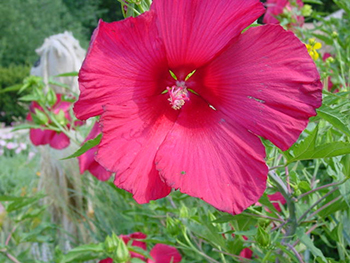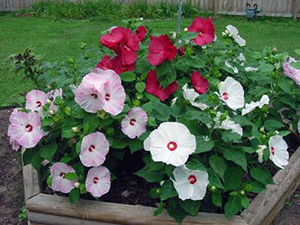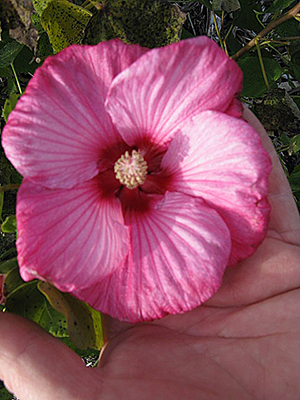Growing Hardy Hibiscus
By Dennis L. Patton, M.S., County Horticulture Agent, K-State Research and Extension/Johnson County
Hardy Hibiscus Provides Great Summer Color
 Looking for that rock-solid perennial to deliver color in the landscape year after year with little fuss? If so, consider adding hardy hibiscus to the planting. This plant delivers on all points. Bold flowers, nice foliage and easy care makes it shine in a Kansas City summer.
Looking for that rock-solid perennial to deliver color in the landscape year after year with little fuss? If so, consider adding hardy hibiscus to the planting. This plant delivers on all points. Bold flowers, nice foliage and easy care makes it shine in a Kansas City summer.
Hardy vs Tropical
Hardy hibiscus is a durable perennial that is often confused with its tropical cousin. Hibiscus are members of the mallow family which have large circular open face flowers. The main difference between the two are in their names, tropical and hardy. The tropical hibiscus is best known as a patio plant that winterkill while the hardy plant returns each spring. Do not get this plant confused with Rose of Sharon, which is also a hibiscus. Rose of Sharon is a woody shrub while this plant is a perennial which dies back each fall.
Hibiscus requirements for success Hardy hibiscus do best in full sun locations. They are tolerant of a wide range of soil conditions from drier to even moist or boggy. Best flowering is achieved when there is ample moisture. Drought stress in the spring will reduce growth and blooms.
Hardy hibiscus do best in full sun locations. They are tolerant of a wide range of soil conditions from drier to even moist or boggy. Best flowering is achieved when there is ample moisture. Drought stress in the spring will reduce growth and blooms.
The plant can be purchased at local garden centers. It forms large fleshy roots which establish quickly. The plant rarely needs to be divided. It remains attractive all summer long before dying back in the fall. Maintenance is the removal of the dead stocks in the late fall or winter. A note of caution: this plant is one of the last perennials to emerge in the spring. Give it time to return for another season of growth.
Newer, compact varieties Many newer varieties of hardy hibiscus are on the market. Older varieties were larger plants maybe reaching six feet or more. Taller varieties can be cut back in the spring after reaching about two feet in height. This keeps the plant more compact and bushy creating a more pleasing look.
Many newer varieties of hardy hibiscus are on the market. Older varieties were larger plants maybe reaching six feet or more. Taller varieties can be cut back in the spring after reaching about two feet in height. This keeps the plant more compact and bushy creating a more pleasing look.
Compact varieties, two to three feet are now on the market. The plant has either a flat green/gray leaf or some have tinges of reddish tones. The leaves have two patterns; one more heart shaped and the other appearing more like a maple leaf. The leaf color and shape vary with the variety as many of these plants have been crossbred creating the diversity.
The flowers of the hibiscus are the real showstopper. Flowering begins in late June and can last into the fall depending on variety and care. Flowers can be big, measuring up to a foot across. They are simple dinner-plate shaped hibiscus with beautiful centers and different hues to create more interest and depth of color.
Flower color ranges from white, pinks, reds and various shapes and bicolors. There have been a number of newer releases of this plant making it more adaptable in various locations in the garden.
Examples of popular varieties are ‘Fireball,’ ‘Plum Crazy,’ ‘Berry Awesome,’ ‘Peppermint Schnapps,’ ‘Blue River II,’ and ‘Cranberry Crush.’ Now is a great time to visit a local garden center as they will be blooming and you can pick up your favorite to add to the garden.

